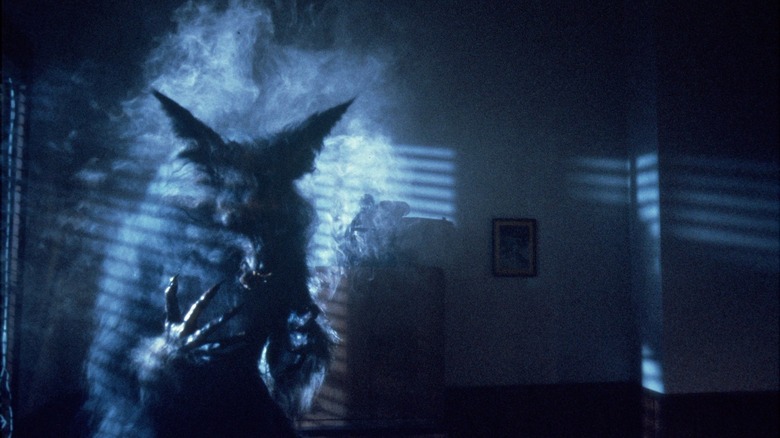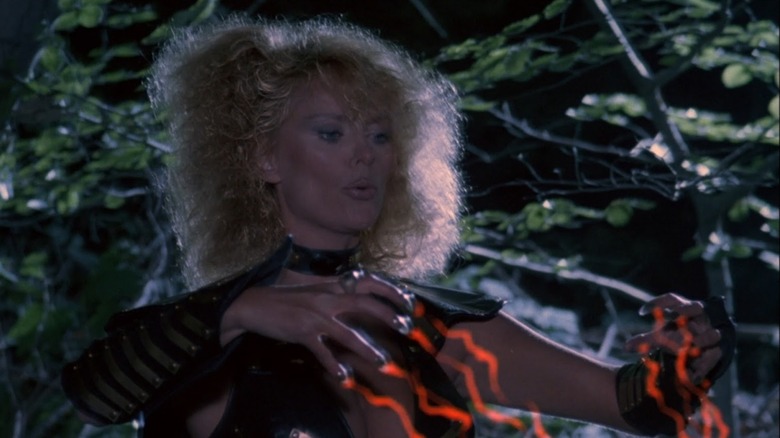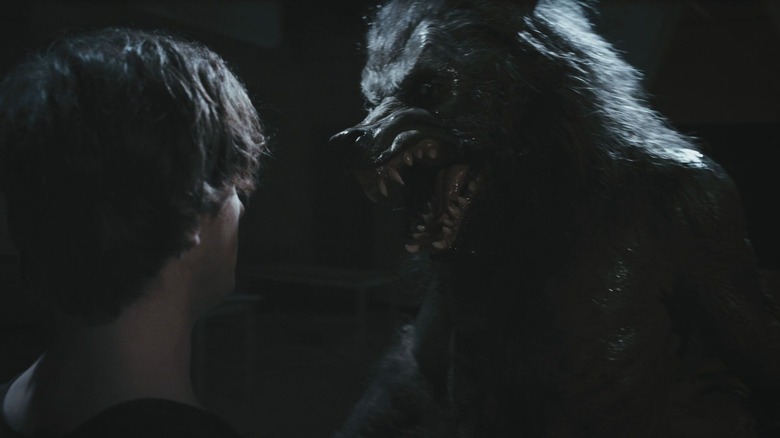The Correct Order To Watch The Howling Movies
Joe Dante's 1981 werewolf flick "The Howling" boasts one of the most impressive werewolf transformation scenes in the genre's history. A vicious serial killer named Eddie Quist (Robert Picardo) confront's the film's protagonist, Karen (Dee Wallace), an investigative reporter recovering from a previous attack at a woods-bound therapy camp. Lit through the slits in Venetian blinds, Quist's face extends and mutates, his mouth ripping into a terrifying wolf grin, his eyes bulging. Karen witnesses the entire transformation and is, naturally, terrified. Quist was already known for his penchant for murder, but learning that he is a werewolf makes him that much more monstrous. The effects were provided by the amazing Rob Bottin.
"The Howling," while a corker of a monster movie, is also a clever satire of then-modern therapy. A certain kind of "touchy-feely" language had come into vogue in the late '70s and early '80s, and therapy was seen as a passing trend for the bourgeoisie. "The Howling" was based on a straightforward horror novel by Gary Brandner, but Dante and his screenwriter John Sayles transformed it into something more comedic and wicked, hoping to use werewolves to prod wealthy a-holes and tiresome trends in modern psychology.
Dante couldn't have predicted that his werewolf flick would spawn sequels, each one wilder than the last. "The Howling" movies contain almost no interconnected mythology; each one feels like the first film in a new series. The rules for werewolf-ism change with every entry, and only the worst film in the series — "The Howling: New Moon Rising" — attempts to bring all the movies together.
A "Howling" marathon is a dizzying experience (I've done it), and it might not be recommended for those with weak constitutions. For strong-willed horror veterans, however, read on to discover the correct viewing order.
Stick with the release order for The Howling
Most of the "Howling" films come handily marked with Roman numerals. For simplicity's sake, you should stick with the release order:
- "The Howling" (1981)
- "Howling II: Your Sister is a Werewolf" a.k.a. "Howling II: Stirba — Werewolf B*tch" (1985)
- "Howling III: The Marsupials" (1987)
- "Howling IV: The Original Nightmare" (1988)
- "Howling V: Rebirth" (1989)
- "Howling VI: The Freaks" (1991)
- "Howling: New Moon Rising" a.k.a. "Howling VII: Mystery Woman" (1995)
- "The Howling: Reborn" (2011)
In 2020, it was announced that a remake of "The Howling" was in development, with "The Flash" director Andy Muschietti attached as director. No further word has emerged since then, however.
As mentioned, the "Howling" films are based on a series of werewolf novels by Gary Brandner. Ambitious lycanthrope fans may also want to read "The Howling" (1977), "The Howling II" (1979), and "The Howling III: Echoes" (1985), should they want to be a completionist.
Prolific Australian director Philippe Mora ("Mad Dog Morgan," "The Return of Captain Invincible") directed the second and third "Howling" films, but they could not be more different in tone. The former is a sex-soaked Eastern European bloodbath with Christopher Lee and the amazing Sybil Danning as Stirba, the werewolf queen. The latter is a gentler ecology fable (it's rated PG-13) about people who turn into lycanthrope versions of the now-extinct Australian thylacine, a marsupial more commonly called the Tasmanian wolf.
"Howling IV" is only subtitled "The Original Nightmare" because it more closely resembles Brandner's original novel, and not because it connects back to Dante's 1981 film. The screenplay for "Howling IV" was co-written by Clive Turner, who also has a cameo as a tow truck driver. We learn in sequels that we should have been paying close attention to that tow truck driver, as he returns in later installments.
The wild Howling continuity
Clive Turner, "Howling" fans will soon begin to see, is the focal point of at least three of the "Howling" sequels. He shows up again in "Howling V: Rebirth" (another film he co-wrote) playing a character named Ray. "Rebirth" is a haunted castle flick that was filmed in Budapest, with Ray being the buffoon who first discovers a vital secret passageway in the castle. He gets killed, if I recall.
Turner doesn't show up in "Howling VI: The Freaks," which was based a little more directly — but only a little — on Brandner's third "Howling" novel "Echoes." The sixth "Howling" film is a bouillabaisse of horror iconography, including a seemingly haunted circus, as well as (sigh) vampires. One of the characters from "The Freaks" drifts into the next film.
"Howling: New Moon Rising" is the sequel on which all the other films pivot, which is a pity because it's a horrendously cheap, terrible film. Clive Turner wrote, directed, and starred this time, setting his werewolf tale in and around Pappy + Harriet's, a notable real-life rock venue in Pioneertown, California. Certainly of note: there are no werewolves in "New Moon Rising." There is a local serial killer on the loose, however, and a character named Ted (Turner) is on the case. He reveals that he was a werewolf investigator this whole time, and that his cameos from previous "Howling" movies were mere disguises he affected during his investigations. He also says that Stirba from "Howling II" has become incorporeal and that he's been chasing down her invisible spirit since 1985, witnessing it possess other characters. It's a bold, bold retcon for an ultra-low budget film that was shot on video.
"Reborn," meanwhile, is a latter-day "Twilight" retread. You can skip that one.


